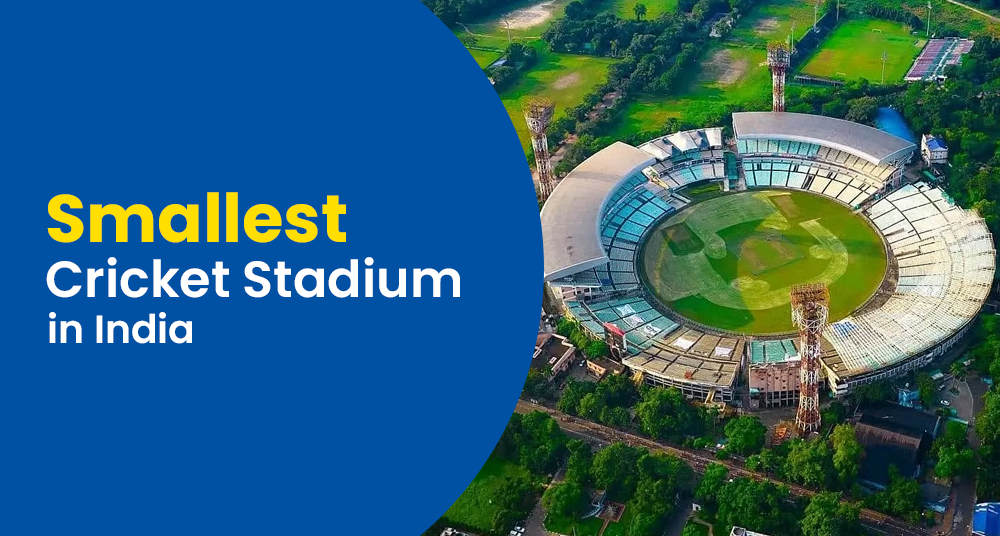Cricket is loved all across India, and every stadium has its own charm. While some grounds are known for their huge capacity, others are famous for their small boundaries that make matches more exciting. Many fans often wonder: Which is the smallest cricket stadium in India? In this blog, we’ll look at India’s smallest stadiums, their boundaries, seating capacity, and why they play such an important role in modern cricket.
Smallest International Cricket Stadium in India (by Seating Capacity)
Not every cricket stadium in India is built to host huge crowds. The Greater Noida Sports Complex Ground is officially the smallest international cricket stadium in India by seating capacity, with space for only 8,000 fans. This stadium proves that size does not define importance, as it has been approved by the ICC and hosted international fixtures, including Afghanistan’s home games.
| Rank | Stadium Name | City / State | Seating Capacity | Average Boundary (m) |
| 1 | Greater Noida Sports Complex Ground | Greater Noida, UP | ~8,000 | 65–68 m |
| 2 | Madhavrao Scindia Cricket Ground | Rajkot, Gujarat | ~15,000 | 65–70 m |
| 3 | Barabati Stadium | Cuttack, Odisha | ~16,000 | 66–69 m |
| 4 | Captain Roop Singh Stadium | Gwalior, MP | ~18,000 | 64–68 m |
| 5 | Nehru Stadium | Kochi, Kerala | ~20,000 | 65–70 m |
| 6 | Indira Gandhi Stadium | Vijayawada, AP | ~25,000 | 65–69 m |
| 7 | Lal Bahadur Shastri Stadium | Hyderabad, Telangana | ~25,000 | 64–68 m |
| 8 | Nehru Stadium | Indore, MP | ~25,000 | 65–70 m |
| 9 | Holkar Cricket Stadium | Indore, MP | ~30,000 | 65–68 m |
| 10 | Greenfield International Stadium | Thiruvananthapuram, Kerala | ~38,000 | 65–70 m |
Greater Noida Sports Complex Ground
The Greater Noida Sports Complex Ground, also known as the Shaheed Vijay Singh Pathik Sports Complex, is recognized as the smallest cricket stadium in India by seating capacity, with room for only 8,000 spectators. Located in Greater Noida, Uttar Pradesh, this stadium was approved by the International Cricket Council (ICC) in 2016 to host international matches.
It became well-known when it served as the home ground for Afghanistan’s national cricket team before they gained Test status. The venue hosted several T20I and ODI matches, including Afghanistan’s series against Ireland in 2017.
Despite its small size, the ground meets all ICC requirements and provides fans with a closer and more engaging view of the action. Its shorter boundaries often make it a favorable venue for batsmen, leading to high-scoring games.
Madhavrao Scindia Cricket Ground
Located in Rajkot, Gujarat, the Madhavrao Scindia Cricket Ground is a compact international stadium with a seating capacity of about 15,000 spectators. Named after the former BCCI President Madhavrao Scindia, this ground has hosted several One Day Internationals (ODIs) and first-class matches over the years.
It became widely known in 1986, when it hosted its first ODI between India and Australia. The ground has witnessed some memorable performances, including high-scoring matches thanks to its short boundaries and batting-friendly pitch.
Barabati Stadium
The Barabati Stadium, located in Cuttack, Odisha, is one of the oldest and smallest international cricket venues in India, with a seating capacity of around 16,000 spectators. Established in 1958, it has hosted numerous memorable matches across formats, including Tests, ODIs, and T20Is.
Known for its shorter boundaries and lively crowd atmosphere, Barabati often produces high-scoring encounters, especially in limited-overs cricket.
Captain Roop Singh Stadium
The Captain Roop Singh Stadium, located in Gwalior, Madhya Pradesh, is another small but historic international cricket ground in India, with a seating capacity of around 18,000 spectators. Originally built as a hockey stadium, it was later converted to host cricket matches and has since become an important venue for both domestic and international games.
This ground is best remembered for a historic moment in world cricket – Sachin Tendulkar’s first-ever double century in One Day Internationals, scored against South Africa in 2010. That innings turned the stadium into a landmark in Indian cricket history.
Nehru Stadium, Kochi
The Jawaharlal Nehru Stadium, located in Kochi, Kerala, is a multi-purpose sports venue that has also hosted international cricket matches. With a seating capacity of around 20,000 spectators for cricket, it is among the smaller international stadiums in India.
The stadium has hosted several ODI matches, including high-profile encounters in the late 1990s and early 2000s. Known for its batting-friendly pitch and shorter boundary dimensions, Nehru Stadium has often produced entertaining, high-scoring matches.
Top 10 Smallest Cricket Stadiums in India by Boundary
| Rank | Stadium Name | City / State | Shortest Straight Boundary (m) |
| 1 | Holkar Cricket Stadium | Indore, MP | 56 |
| 2 | Captain Roop Singh Stadium | Gwalior, MP | 64 |
| 3 | Arun Jaitley Stadium | Delhi | 64 |
| 4 | Sawai Mansingh Stadium | Jaipur, Rajasthan | 137 |
| 5 | Nehru Stadium | Kochi, Kerala | 140 |
| 6 | Green Park Stadium | Kanpur, UP | 150 |
| 7 | Moti Bagh Stadium | Vadodara, Gujarat | 160 |
| 8 | Rajiv Gandhi International Stadium | Dehradun, Uttarakhand | 160 |
| 9 | Barsapara Cricket Stadium | Guwahati, Assam | 160 |
| 10 | Lalbhai Contractor Stadium | Surat, Gujarat | 160 |
Impact of Small Stadiums on Cricket Strategy
Small cricket stadiums may not have the capacity of giant arenas, but they offer a dynamic playing environment. Short boundaries encourage aggressive batting, but bowlers and fielders must be tactical to prevent easy runs. Captains often plan their moves more carefully in these grounds, considering pitch conditions and boundary lengths. For fans, small stadiums provide a closer and more thrilling view of every shot and wicket.
Final Words
While India is home to some of the world’s largest cricket stadiums, its smallest grounds hold their own charm and importance. From the Greater Noida Sports Complex Ground to Holkar Stadium, these compact venues offer thrilling matches, shorter boundaries, and a unique experience for both players and fans. Small stadiums may be limited in size, but they deliver intense action, strategic gameplay, and unforgettable cricketing moments. Whether you’re a player adjusting your tactics or a fan enjoying the close-up view, these stadiums prove that in cricket, excitement isn’t measured by size alone.
Useful Resource: Sheikh Zayed Stadium Pitch Report






What do you think?
It is nice to know your opinion. Leave a comment.